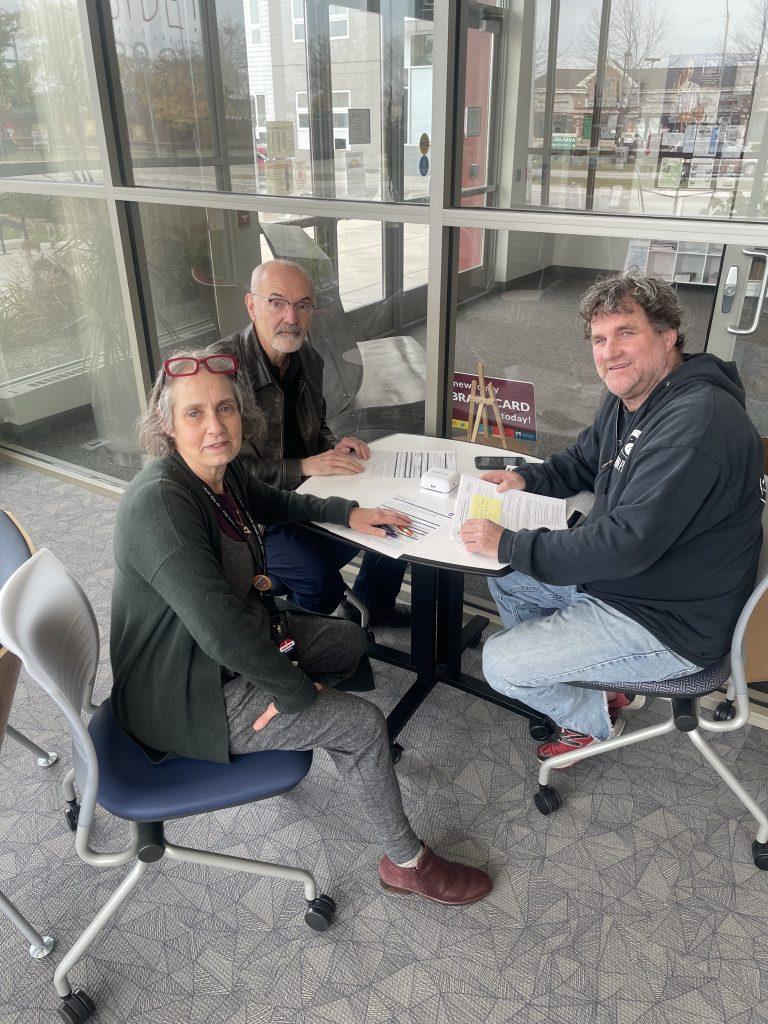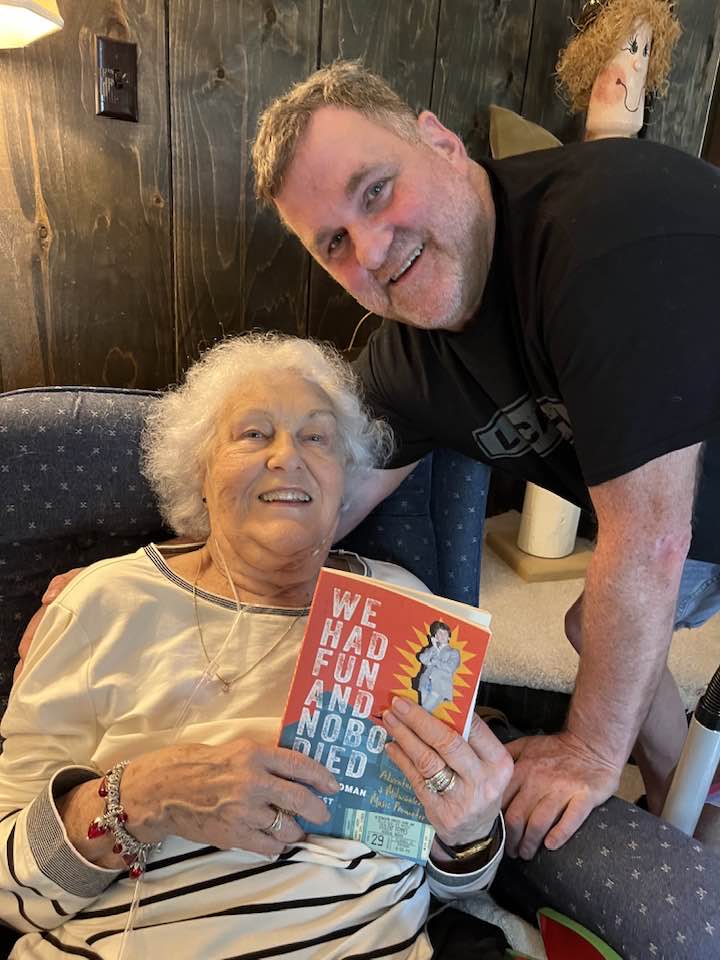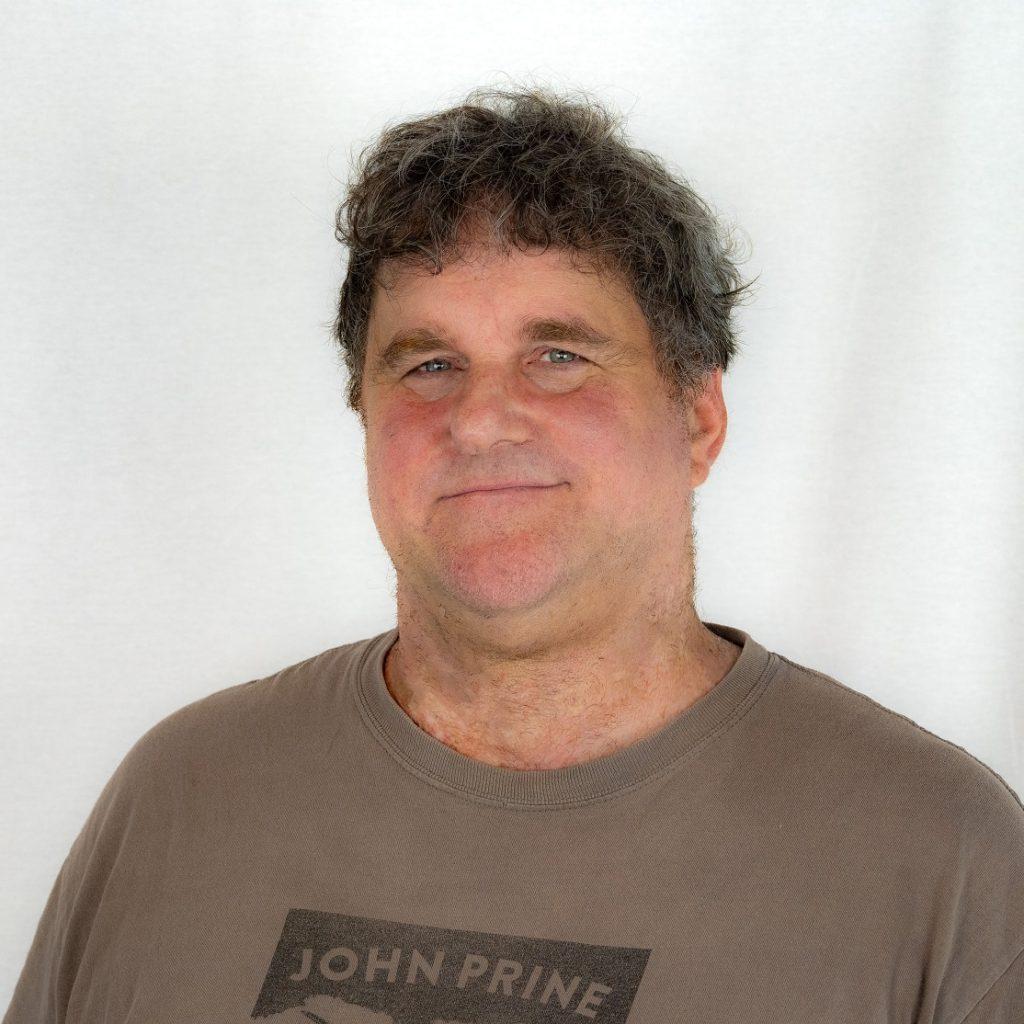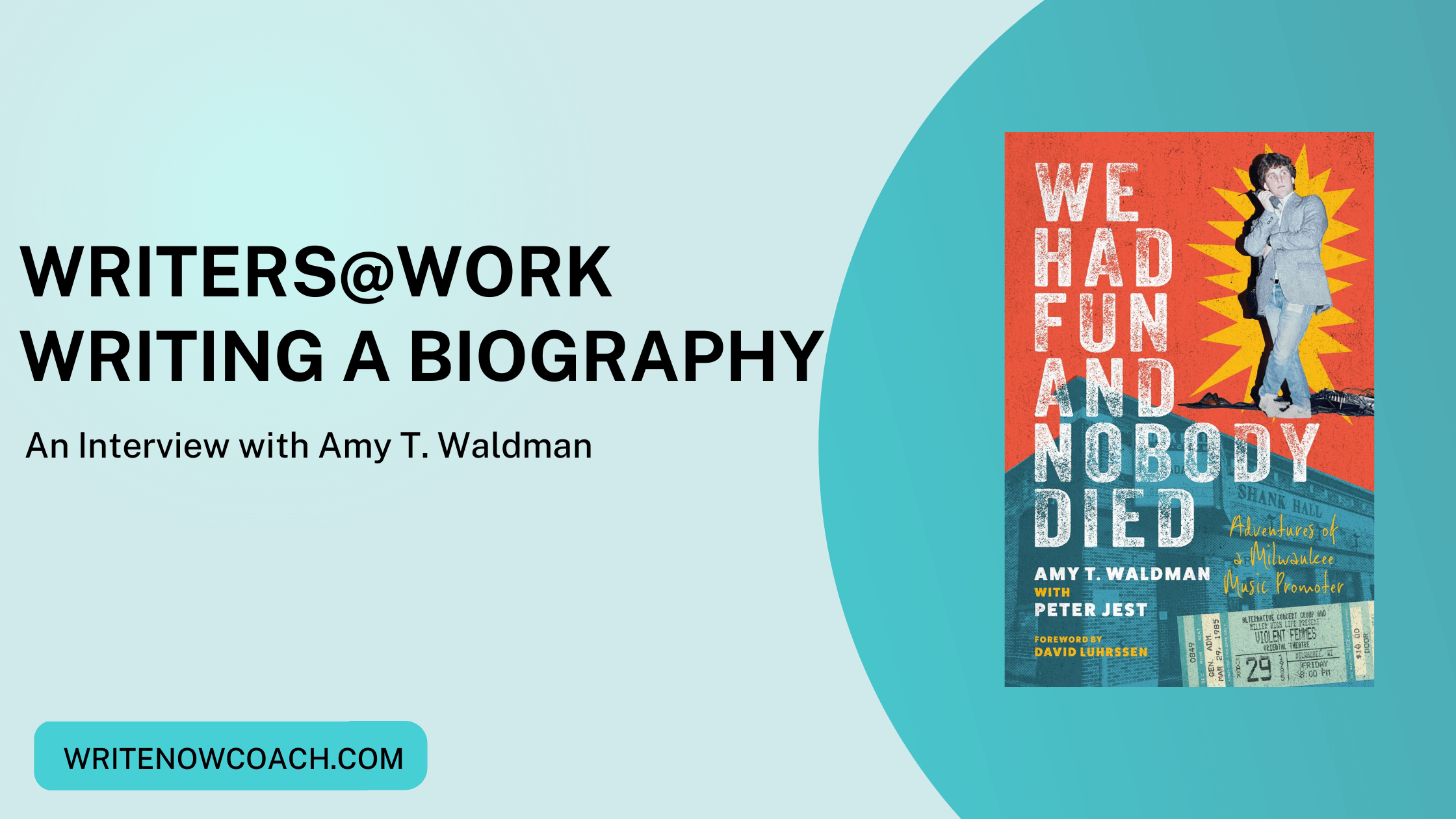Writers@Work: Writing a Biography
An Interview with Amy T. Waldman
Welcome, Amy! Tell us about your new book, We Had Fun and Nobody Died.
Hi, Rochelle! Thanks so much for having me! The book’s subtitle is “The Adventures of a Milwaukee Music Promoter,” and it’s the story of how a socially awkward introvert grows up to be a club owner and concert promoter.
You wrote the book with Peter Jest, who is also the subject of the book. Can you talk about the journey from book idea to contract?
The book was Peter’s idea. I came to him with a completely different vision. It was May of 2020, and the pandemic was raging. Peter had started posting old contracts from the ‘90s on his Facebook feed. One was for a Pearl Jam show at the Eagles Ballroom and one was for Alanis Morrisette at Shank Hall—he’d paid $500 for both acts. I immediately flashed back to a night I’d had him and another friend over for dinner—also in the ‘90s. We’d stumbled onto the ultimate Peter Jest Parlor Game. It turned out that Peter has one of those memories where, when you throw out a random date, he can tell you who was playing his club. So, my mind went to “…has saved every scrap of paper that has anything to do with his business…”, “remembers every date…”, and “I aced Digital Libraries.” *
*(A little context: When Peter and I met in the ‘90s, he was a baby club owner and I was a baby music journalist. I liked him pretty much instantly because I do well with people who are direct and honest, and Peter is both of those things. He continued to do what he was doing when I met him. I have been a newspaper reporter, a project coordinator, a teacher, and in 2008, started graduate school at UWM (one class at a time around my full-time job) and crossed the stage in 2014 with a Masters Degree in Library Science.)
Back to your question: I sent Peter a direct message on Facebook that said: “You’re sitting on a gold mine. Call me.” Which he did. And I made my pitch, which was that we could build him Virtual Shank Hall, put it behind a paywall, charge 49¢ a show or $17 a year for an “All Access pass” and he could sail through the pandemic with an income stream.
His response was “That’s interesting, let me talk to my lawyer.” So, he called his lawyer, then he sent me this on Facebook Messenger at 9:45 a.m. May 25, 2020, to which I responded pretty much immediately:
Peter: my lawyer had a good idea-I should write a book since it is your call that sparked this would you be interested in doing a book with me about my life in the music business?
Amy: TOTALLY! OMG. That would be FABULOUS.
So, that was the beginning. We got together and when I had three chapters done, I sent it to two friends with industry knowledge. Based on their feedback, my next step was to reach out to the Wisconsin Historical Society Press.
That had been my first choice, but I felt kind of morally obligated to at least explore the possibility of a Big Five publisher, for Peter’s sake. The truth is that the Historical Society Press was my first choice when I thought about a publisher, for two reasons. One was that this is a Wisconsin story; the other was that if the book made any money, I wanted as much of it as possible to stay in Wisconsin.
I’d never written a book proposal before, but I knew about them. And I should probably have recognized it as a sign of just how good the Press is when I found a proposal form on their website (in two formats, no less!). So, I filled it out and sent it in on July 7, 2021.
This is the text of the email I sent along with the proposal:
“Enclosed, please find a proposal for “We had Fun with Him and Nobody Died: How Peter Jest Transformed Wisconsin’s Music Scene.”
The book traces Peter’s evolution from socially awkward introvert whose own musical talent ends at finding Middle C on a piano to one of the Midwest’s most successful music promoters. The story mostly takes place in Milwaukee, with stops in Madison, Oshkosh, Wausau, Eau Claire, LaCrosse, Manitowoc. There’s also a brief out-of-state diversion that occurs when 20-year-old Peter hits the road with the Violent Femmes as their tour manager. He returns with a lifelong friend in bassist Brian Ritchie, whose description of that tour is the book’s current working title.
Peter began transforming Wisconsin’s music scene in 1982, when he proposed bringing national acts to the University of Wisconsin-Milwaukee’s campus. He’s continued that transformation through relationships he built with artists like John Prine and Arlo Guthrie, making it possible for people in smaller communities around Wisconsin to have see them and other nationally known acts without having to travel to larger population centers. And he has leveraged Milwaukee’s proximity to Chicago in the service of bringing icons like Leonard Cohen and Patti Smith to Milwaukee for the first time in decades (38 years for both artists).
My first encounters with Peter date back to 1991, when I was a newly-minted journalist writing feature stories about acts performing at his club, Shank Hall. We became friendly and, eventually, friends. During the pandemic, he decided he wanted to do a book and asked if I’d be interested in writing it. I was. I am. It’s a great Wisconsin story – it’s a great story – how a college dropout with asthma grows up to own a houseful of critters and one of Milwaukee’s longest-running live music venues.”
Within moments of submission, I received this:
“Thank you for your submission to the Wisconsin Historical Society Press. We look forward to reviewing your proposal….
“Our editorial team will meet to review your proposal. We may also ask a reviewer in your particular subject area to read and respond to this proposal. You can expect to hear from us again in six to eight weeks. Please let me know if you have any questions during that time.”
That was July 7, 2021. By then, I’d completed three chapters and was working on a fourth. On August 4th, I got this:
“Thanks so much for submitting this proposal. We are intrigued!”
As soon as I finished hyperventilating, I forwarded the email to Peter and Dave Luhrssen, who was writing the foreword to the book and also serving as our general on-hand advice guy. This was the subject line: “!!!!!!!!!!!!!!!!!!!!!!!!!!!!!!!!!!!!!!!!!!!!!!!!!!!!!!!!!!!!!!!”
Bottom line is—as you probably know—there ended up being a book. I thought I knew a lot about writing, and I do, but I didn’t know anything about the process between having a manuscript potentially accepted for publication and the negotiations—formal and/or informal—that take place between “We are intrigued” and “Attached is the full book contract in draft form for your review.”
One thing I appreciated from the start about Kate Thompson (who, when Peter and I started this project, was the Press Director and is now focused on acquisitions) was how thorough she was in her vetting process about whether our work styles would mesh. As someone who started my career working in newsrooms and who attends a monthly writer’s master class (with Judy Bridges of Redbird Studios), I’m used to being edited and very open to feedback. At the same time, I don’t back away from standing firm on something I feel strongly about while remaining willing to hear an informed perspective that I may not have considered. Kate made it clear that there would be a lot of people involved in the project, which I found exciting and reassuring – what I heard wasn’t “We’re micromanaging and changing things,” it was “We are going to do everything possible to transform your manuscript into a book that is the best possible version of itself.” Which is pretty much what has happened.
About contracts, though. Kate made it clear that once I’d signed and there was a deadline, I needed to make it – or else. That terrified me enough that I didn’t actually sign it (with Peter & Dave) until two weeks before I turned in the manuscript. That said, every time I finished a chapter, no matter how rough or raw it was, I sent it to Kate, so she knew I was still working!
Also, I also knew nothing about what happens between submitting a 56,812-page Word document to a publisher and receiving a finished book in the mail. That has – and continues to be – a real education. The good news is that working with the Wisconsin Historical Society Press on this project has been the equivalent of going to a top-tier school. If you ever have the chance to do a book with them, take it!

Of course, everyone is curious about how you write a book with someone else. How did you two work together? Can you talk about the writing process?
This is an easy one! The short answer is that I did the writing. The longer answer is that while I joke that no one should go to a show I promote and no one should read a book Peter Jest writes, the truth is that we both stuck to what we know and are good at, and this is the result. Because I’ve known Peter for so long and because of the way I got to know him, it was at first by reputation.
When I met him face-to-face, I immediately understood that he was misunderstood—people took his direct manner and strong moral code personally. But as someone who isn’t a fan of artifice, I liked that. So I liked him. When Peter pitched the book idea, I think (I haven’t actually asked him), he was thinking about being able to share some of the highlights of his career and the people he’s worked with that readers would find interesting. I agreed with that, but I also knew that Peter was interesting, and it was his story I wanted to tell. Writing the book gave me a chance to ask him all kinds of questions about how he’d ended up where he was and trace things backwards.
One of the first things he did was to get a hand-held digital recorder and start talking into it. I’d transcribe those recordings, which gave me insight into what Peter thought was important. About a year and change into it, I began talking to other people, but only after I’d really immersed myself in Peter’s worldview and vision. Peter didn’t do any writing. What he DID do was read everything I wrote as I wrote it (I’d send him finished chapters), let me know if I’d gotten something wrong so I could correct it, and be very patient with me when I kept getting something wrong.
Three things here that bear mentioning:
1. It’s a huge act of courage to trust someone to tell your story, and I never wasn’t thinking about that. That said, I didn’t want to write a hagiography—Peter isn’t perfect. None of us are – and Peter’s imperfections are a big part of what make him and this book (hopefully!) interesting. He was okay with that, which is huge and which gave me the ability to write his story freely. The other thing was that even when he got owly about things he thought didn’t matter, he trusted me to enough to surrender to my variations on “No! This is important!” The most vivid example of that is the Femmes tour—he didn’t understand why I was so fixated on 21 days from 40 years ago. But I knew it was huge, both from a developmental and narrative standpoint, and I wanted to get it right. You can’t be afraid to be a pain in the ass in the service of something bigger than injured feelings when you’re working on a project like this.
2. Consideration for the privacy of others. I tracked down one person I’d really been trying to find, who was not happy about the prospect of finding their youthful antics in print. In the ensuing years, this individual had settled into a quieter life, raising kids who had no idea about aspects of their parent’s past. When I wrote the passage involving them, I was very deliberate in choosing how to frame it. My editor came back with a question and the desire for more information. I explained the situation and she left it as it stood. Another situation was two people who are portrayed during what one of them described to me as “not my finest moment.” They showed up at a 1989 public hearing to argue that Peter shouldn’t get a liquor or entertainment license. I tracked them both down to confirm the story and am grateful to both for doing so.
3. Writing a book with a non-writer. In addition to the education we’ve both gotten since submitting the manuscript and receiving a finished book in the mail, Peter gave me a window into about how some non-writers think about how writers work. When we first started this project, he said “Do you think you can get it done in six months? My mom is turning 90 next year.” And I looked at him and said, “Wow! No pressure!” I think he might have thought that you just sit down and words pour out. Which, as anyone who writes knows and that Peter has since learned, is not how it works! (Note: I finished the first part of the book by Peter’s mom’s birthday and bound a copy for her. She is turning 92 soon, read the finished book, and sent me a beautiful note**.)
**Who cares about bad reviews when you have the Mom stamp of approval?

Peter and his mom
You wrote this book while working full time at the library. What are your tips for getting writing done?
SUCH a great question! Some people can get up early and write for an hour and then come back to it the next day, and I’m kind of jealous of those people, because I am not one of them. One of the things I learned about myself as a writer through this experience is that I need long stretches of uninterrupted writing time. My job is a hard 40 hours a week, and that’s non-negotiable (so it’s a good thing I love it!). But I discovered that if I set aside one day a week as a writing day and the other for all the “life stuff” (laundry, cleaning, groceries), I was able to kind of work out the scenes and issues in my head when I wasn’t writing and then on my writing day, really get a lot done in four to six hours. I have another book I’m getting ready to work on, but don’t plan on starting that practice again until I’m through the time and effort that goes into promoting a book – something I’m learning about right now. But it is comforting to know I have an established method and practice, and I’m looking forward to taking that into my next project.
What are you reading now?
I just finished Malcolm MacDowell Woods’ beautiful novel “What the Tide Leaves Behind,” and “Sandwich” by Catherine Newman” and am about to start “The Dictionary People” by Sarah Ogilvie.
About the authors

Amy T. Waldman is an award-winning writer and editor who has written feature articles, reviews, profiles, and essays for a range of publications, including “Fresh Sounds,” a biweekly column of record reviews for the Marshfield News Herald. She currently works as a reference librarian at the Milwaukee Public Library.

Peter Jest has promoted music in Wisconsin and the Midwest for more than forty years and is the owner of the music venue Shank Hall in Milwaukee. This is his first book.









